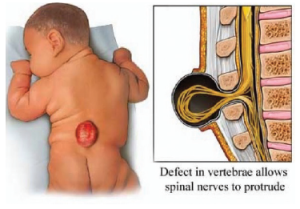 What is spina bifida?
What is spina bifida?
Spina bifida is a type of birth defect called a neural tube defect. It occurs when the bones of the spine (vertebrae) don’t form properly around part of the baby’s spinal cord. Spina bifida can be mild or severe.
The mild form is the most common. It usually doesn’t cause problems or need treatment. You can’t see the defect, but some people may have a dimple, birthmark, or hairy patch on their back. Most people with this form don’t know they have it until they get a back X-ray for another reason.
A rare and more severe form is meningocele (say “muh-NIN-juh-seel”). In this form, fluid leaks out of the spine and pushes against the skin. You may see a bulge in the skin. In many cases, there are no other symptoms.
The most rare and severe form is myelomeningocele (say “my-uh-loh-muh-NIN-juh-seel”). It’s what most people mean when they say “spina bifida.” Part of the spinal nerves push out of the spinal canal, and the nerves are often damaged. You may see a bulge in the skin. In some babies, the skin is open and the nerves are exposed.
What causes spina bifida?
The exact cause of this birth defect isn’t known. Experts think that genes and the environment are part of the cause. For example, women who have had one child with spina bifida are more likely to have another child with the disease. Women who are obese or who have diabetes are also more likely to have a child with spina bifida.
In India, upto 70% of Spina Bifida cases are due to folic acid (a-B complex vitamin) deficiency.
Unfortunately, most Indian women are unaware of this condition, although the incidence of Spina Bifida and related conditions (neural tube defects) in India is one of the highest in the world.
